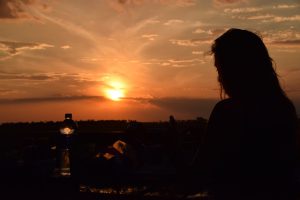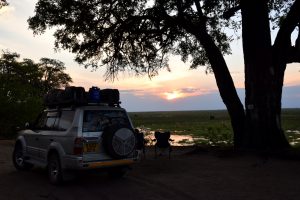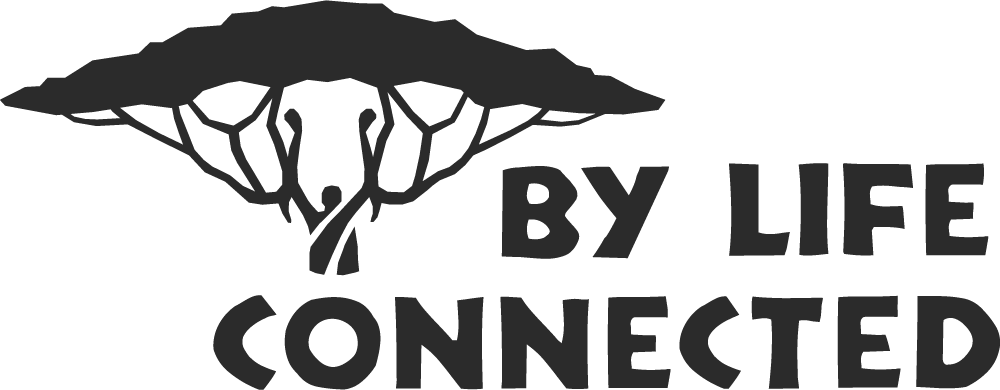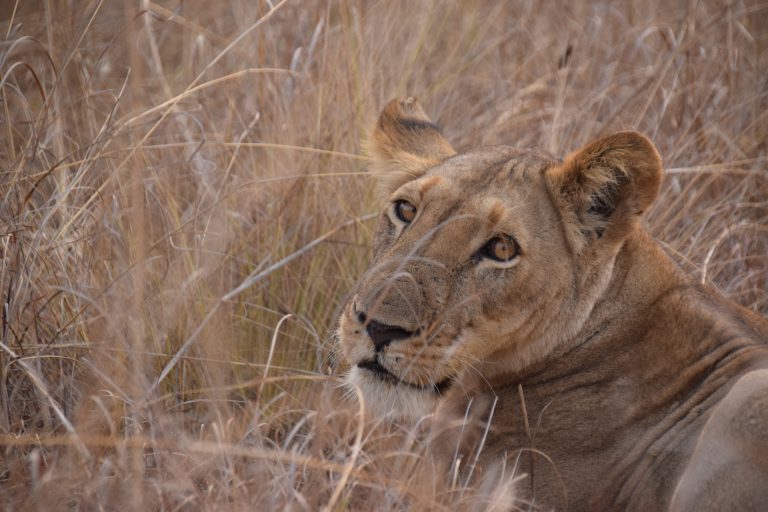While writing this story, outside on a chair, we are looking at an elephant heading our way… wondering if he will come closer (also wondering if we would like it if he would). He is relaxed, casually browsing with his 5th leg slapping against his underbelly. Show-off! No match to be found here, even our local ‘guide’ (more on him later) looks impressed. Anyway, while the elephant walks slowly around us we are astounded by the huge number of elephants here in Botswana. Five days ago, we entered Chobe National Park and travelled all the way down through Savuti and on to Khwai/Moremi NP where we are now. Our adventure started in Kasane for what we hoped was going to be the best wildlife experience of the trip! Expectations were high and we were excited to start our journey through the African wilderness. Before we entered Chobe with our car, we decided to book a boat tour over the Chobe river. Around 15.30 we boarded the boat which could just as well have been a German retirement home on the water; except for us and a young German couple, the remaining 40 persons were probably using up their pension. Luckily, they did not spoil the experience, which was a refreshing experience after driving so many kilometres. For about three hours they navigated and parked us close to hippos, elephants, crocs, antelopes and birds that lived in and along the river. While having the pleasure of sipping a cold cider, we had some wonderful sightings.
The following morning, we arrived at the entrance gate of Chobe National Park at 7am precisely (opening time for self-drivers) to be ahead of the others. The plan for the day was to drive along the Chobe Riverfront (a route of about 50 kilometres). The best sightings were a lion and lioness (a bit hidden in the bushes), a baby baboon riding on the back of her mother (Jiihaa!), a lot of fish eagles and a huge herd of about 200 elephants. The last one took our breath away. We entered a viewpoint that provided us an overview of a cleared area next to the water that was filled with elephants. Later, we found out that many small herds of elephants come together at places where water or/and food is plentiful. Here they’ll form mega herds of hundreds to even a thousand elephants. However, they are only able to do this in this region, because Botswana houses about 250.000 elephants. This is about 25% of the world’s population! An absolute elephant paradise!
Later that afternoon we arrived at Muchenje where we filled the petrol tank for the last time and stayed at Muchenje campsite for the night. While sitting on the deck with our dinner, we had a beautiful view of the sunset. One of the owners joined us, a former British man (he left the UK about 40 years ago), and we talked about the area, Botswana and it’s presidents. The next morning we relaxed a bit at the pool and then left for the remaining part of Chobe (Linyanti and Savuti).
Before entering the park there was a sign “engage 4×4, deep sand ahead”. We have been told to do this before where we didn’t listen and everything was fine, so we ignored this sign as well, Sisi would be able to handle anything. But the sand got deeper and deeper and after a few kilometers we did decide to stop and deflate the tires for more traction. That did the trick and we drove on until we stumbled onto a vehicle that was stuck in the deep sand. The main problem with the sand is that in between the tracks of tires the sand is elevated. Vehicles with relatively low clearance level will drag there bottoms on the sand, creating more friction, until… they come… to a stop. This happened with the Australian (Eddie) and Norwegian (Vera) couple we run into. As good citizens we got out of the car and walked towards them, equipped with our spade, and a big smile on our faces. They responded in kind. You know those people that take everything as it is and try to make the best out of it? Meet Eddie and Vera. What happened was that they had stopped without thinking about the sand, because there were elephants next to the road! As soon as the elephants left, they hit the gas, but nothing happened… They were stuck. And that’s when we came in. We started to recover the car together and while reaching under their car we learned that it is actually really fun to dig someone else’s car out of the sand. Eddie told us about reading that “this road swallows cars for breakfast”. An exciting prospect, considering we are lying under a car right at the beginning of this road. After a few tries and pushes the car was out. Now it was our turn… Kellie took a sprint and went through this bit in one go! On the other side we met up with Eddie and Vera who thanked us with a cold beer. We learned that they were heading the same way as us and left in convoy together.

Our sunset view dinner from the deck at Muchenje campsite.
Only a few kilometres further we had to stop again. Not for Eddie and Vera, but for a car filled with four Dutchies. This makes it sound like there are loads of cars on this road, but actually these were the only cars we came across. And all of them got stuck in the sand. The Dutchies told us that this was the third time (!) that day that they got stuck. And in the following 5 km, we helped them recover their car three more times… Welcome to the African bush! We finally told them to keep the car in low gear, try to drive on the side of the road instead of in the tracks to remain a high clearance, and just keep hitting the gas no matter how much noise your car makes. Plus, we drove ahead to find the best parts of the road and clear some of the deepest sand. And that’s when they finally managed to get through the last 8 km.
Our car was fine and we made it to Linyanti with our confidence skyrocketing. Noticing that our 98’, self-bought and fitted, Landcruiser could take on all that Africa has to offer better than many of the far newer, and much more expensive, rental cars made us feel really good. In addition, we got the best campsite of the camp, with a great overview of a small river. At arrival we saw elephants grazing and enjoying the water down in the river in the light of the setting sun. It doesn’t get any better than this! Because of the amazing view we invited Eddie and Vera to stay at our campsite. They willingly accepted and we had the most wonderful braai. A true African feast; with beetroot salad, potato salad, capsicum, corncobs with butter, chicken and boereworst. The rest of the night we spent talking and laughing around the campfire; the perfect ending of an exciting day!

Our camping spot at Linyanti. If you look closely, you can find the elephants on this picture!
The next morning we decided to wake early to search for wildlife with Eddie and Vera. We took some of the loops in search of the lions we had heard that night, and the tracks we found that almost moved into our camp. All the campsites we booked in game areas, are not fenced, so any animal can walk through, which makes camping a lot more exciting! We didn’t find the lions, but we found some elephants and a roan antelope. From there on we took the road that, we thought, lead us to Savuti (in the middle of Chobe). After a few kilometres we found a huge dead elephant skull along the road. We stepped out of the car to stretch our legs and make some pictures of it. At the same moment a helicopter flew over us and started to circle the area around us. We waved like well-behaved tourists, to show that we are not poachers. What poacher would wave at a helicopter, right? But we were pretty nervous. Even more so when the helicopter started to land on the same road we were parked! At that moment I thought we were in a whole lot of trouble. Pretending confidence though, we walked towards the helicopter from which three game guards, one with a big rifle, exited. Even more nervous. Once cleared from the helicopter they asked us what we were doing here. We answered that we were interested in the elephant skull . Then they asked us if we weren’t scared of lions. We answered that we weren’t. Luckily, this broke the ice and they followed us to the skull. They began to explain how you can see if an elephant died of natural causes or poaching, as this was the reason they landed in the first place. We just happened to be there… Afterwards, they stressed that we shouldn’t leave the safety of the car while in the park and they pointed us in the right direction. We, of course, waited for the helicopter to ascend before turning around and driving off. Another experience added to the list!
Along the road we stopped next to a big elephant bull. We think he was curious as he kept coming closer to the car. He didn’t send any warning signals to us so we stayed put and waited for him to pass… but he didn’t. He came even closer and at a certain moment I could have touched his trunk if I wanted to. At that moment though he got too close for comfort, and I decided to move the car slowly forward. My heart was pounding like crazy while I watched how he would respond to revving of the engine. He stayed relaxed though and just crossed the road behind us. With big eyes Eddie and Vera looked at us (they were in front), and we exchanged how exciting that was. After this experience the road got worse; deep sand for kilometres in one stretch. At this moment we started to notice that our fuel was going a lot faster than normal, which worried us a lot because we had a long way to go! We calculated that the car was consuming 1 litre for every 4 kilometres, which is ridiculously inefficient; normally it is about 1 litre for every 8 kilometres (also not great). We did not even think of driving back to Muchenje though; we had an expensive reservation at Savuti that evening. This created some uncertainty as we were not sure if would be able to make it to the other side (about 250 kilometres further). For us though, the only option was forward, deeper into the wilderness…
Arriving at the entrance gate in Savuti we heard that a lion pride had killed an elephant. We drove around but couldn’t find any signs of the kill, which should have been only 300 meters from the gate… Hunger won from curiosity, and we first made a quick lunch. With our bellies filled we continued the search. Kellie and I eventually found the lions by tracking the tracks of other cars into the bush. They were lying under a bush, their bellies even thicker than ours. We never found the elephant. From there we had an afternoon game drive through the Savuti Marsh, a supposedly wet area but at this time of year no water drop to be found. Nevertheless, the plains were stunning with cumulus clouds in the background. And to stretch our legs we even climbed a small hill to visit some rock art.
Overall, the wildlife on this drive was a bit scarce, which we hadn’t expected after reading the Lonely Planet (expectations are always bad). So we were kind of disappointed when we drove back towards camp. Suddenly, we saw a big dust cloud ahead of us; the sign of a big herd (buffalo or elephant) on the move. It were about a hundred buffalo’s and they were heading for the waterhole that was very close to the lions we had found earlier! All the buffalo’s gathered around the waterhole, a hole way too small to accommodate them all. Then an elephant tried to push through the herd of buffalo’s to get to the water, which was already occupied by two hippo’s as well. Just before it reached the water, it got scared of something and ran away, trumpeting. Then, out of nowhere, the lions suddenly appeared! They were after the buffalo’s and the herd started to move. Not chaotically, as one might expect, but very organized. We could feel and hear the enormous amount of hoofs smashing against the ground as a big cloud of dust covered the area. After a few moments the dust settled and a battleground between prey and predator emerged; the leaders of the buffalo’s and lions were facing each other. In turn they charged one another, measuring the strength and confidence of their opponent. One bull buffalo charged! The lions retreated, afraid of the massive horns of the buffalo. They only stayed put for a bit, and then the lions set in the chase again. The lions made several attempts to brake the formation of the buffalo herd to seclude one from the rest. And this went on and on right in front of us. It felt like we were in a National Geographic documentary! The only thing we missed was the voice of David Attenborough. The hunting lions were with five lionesses and a one young male, the adult males were being typical lions. We found them lying about 50 metres away; watching the spectacle just like us. The kings of the savanna do not hunt, they get fed. Unfortunately, it was getting really dark as the lions continued the hunt. We knew we had to go back to camp, even though we did not see the conclusion of the battle. Without a choice, we decided to look for any signs of who won in the early morning the next day. At the campfire, we talked the day and especially the evening over with Eddie and Vera while preparing another feast. What a sighting!! We slept like babies (didn’t even wake when a small herd of elephants walked through our camp).
The next morning we said goodbye to Eddie and Vera (we had an amazing time with you guys!!), and headed to where the battle had taken place the previous night. And we couldn’t believe our eyes! We found a carcass surrounded by lions, however, it was not a buffalo! Apparently, the buffalo’s had won the battle and instead the lions had killed a medium-sized elephant! Because of the huge population of elephants in the region, the local lions had become elephant hunting experts, very cool! We stayed at the kill for a couple of hours, watching them feed in turns and walk to the waterhole to drink. After a while though it got too hot for them to stay in the open and one by one they found a place in the shade. For us this was a sign that we could move on, on towards the largest inland delta in the world: the Okavango Delta.
– Lars –





Pingback: Our visit to the Okavango Delta - Everything we could wish for